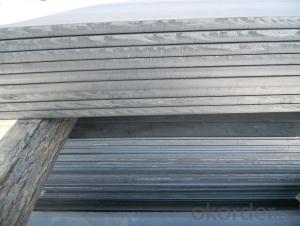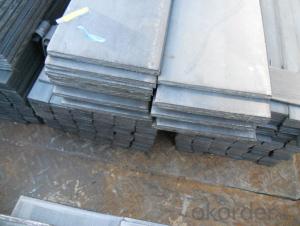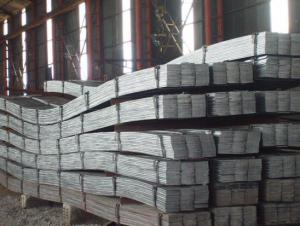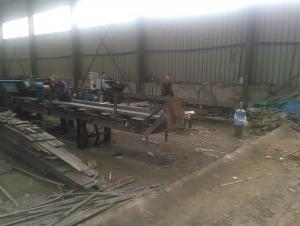Hot Rolled Seel Flat Bars in Material Grade Q235 and High Quality
- Loading Port:
- Tianjin
- Payment Terms:
- TT OR LC
- Min Order Qty:
- 25 m.t.
- Supply Capability:
- 10000 m.t./month
OKorder Service Pledge
OKorder Financial Service
You Might Also Like
Product Description:
OKorder is offering high quality Flat Bar at great prices with worldwide shipping. Our supplier is a world-class manufacturer of steel, with our products utilized the world over. OKorder annually supplies products to European, North American and Asian markets. We provide quotations within 24 hours of receiving an inquiry and guarantee competitive prices.
Product Applications:
Flat Bars are ideal for structural applications and are widely used in the construction of buildings and bridges, and the manufacturing, petrochemical, and transportation industries.
Product Advantages:
OKorder's Flats Barare durable, strong, and resist corrosion.
Main Product Features:
· Premium quality
· Prompt delivery & seaworthy packing (30 days after receiving deposit)
· Corrosion resistance
· Can be recycled and reused
· Mill test certification
· Professional Service
· Competitive pricing
Product Specifications:
Manufacture: Hot Rolled
Grade: Q195 – 235
Certificates: ISO, SGS, BV, CIQ
Length: 6m – 12m, as per customer request
Packaging: Export packing, nude packing, bundled
Chemical composition of Q235
Alloy No | Grade | Element(%) | ||||
C
| Mn
| S
| P
| Si
| ||
Q235
|
B
|
0.12—0.20 |
0.3—0.7 |
≤0.045 |
≤0.045
|
≤0.3
|
Physical properties of Q235
Alloy No | Grade | Yielding strength point(Mpa) | Tensile strength (Mpa) | Elongation after fracture(%) | ||||||
Thickness (mm) | Thickness (mm) | |||||||||
≤16 | >16--40 | >40--60 | >60--100 | ≤16 | >16--40 | >40--60 | >60--100 | |||
≥ | ≥ | |||||||||
Q235 |
B |
235 |
225 |
215 |
205 |
375--500 |
26 |
25 |
24 |
23 |
FAQ:
Q1: How soon can we receive the product after purchase?
A1: Within three days of placing an order, we will begin production. The specific shipping date is dependent upon international and government factors, but is typically 7 to 10 workdays.
Q2: How do we guarantee the quality of our products?
A2: We have established an advanced quality management system which conducts strict quality tests at every step, from raw materials to the final product. At the same time, we provide extensive follow-up service assurances as required.
Q3: The products are invoicing on theoritical weight or on actual weight basis ?
A3: We can do it in both manners, according to buyers' requiremnet.
Q4:What is the normal tolerance of your products?
A4:It's 7-9% ,we can do it according to buyers' requirement.
Images:


- Q: How do you determine the strength of a steel flat bar?
- The strength of a steel flat bar can be determined through various methods, including tensile testing, hardness testing, and yield strength calculations. Tensile testing involves subjecting a sample of the flat bar to a controlled pulling force until it reaches its breaking point, measuring the maximum stress it can sustain. Hardness testing measures the material's resistance to indentation, providing an indication of its strength. Yield strength calculations involve determining the stress at which the steel begins to exhibit permanent deformation. By utilizing these methods, the strength of a steel flat bar can be accurately determined.
- Q: Are steel flat bars heat-treatable?
- Yes, steel flat bars are heat-treatable.
- Q: Can steel flat bars be threaded?
- No, steel flat bars cannot be threaded as they do not have a hollow center like a pipe or a tube, which is necessary for threading.
- Q: How can copper cables and flat steel be welded together?
- If it is filamentous, press press terminal (open type to cut tin). The terminal is pressed onto flat steel for corrosion protection. It is not allowed to be directly pressed to flat steel, so it must be brazed to flat steel by copper
- Q: What is 40x4 galvanized flat steel, please?
- Main application: galvanized flat steel is used as material, used for making iron, tools and machinery parts. It is used as frame, structure and escalator for building.
- Q: Are steel flat bars suitable for electrical conductivity applications?
- No, steel flat bars are not suitable for electrical conductivity applications.
- Q: Are steel flat bars available in different colors or finishes?
- Different colors or finishes are typically not available for steel flat bars. The main purpose of steel is its strength and durability, rather than its aesthetic appeal. Nevertheless, there are cases where steel flat bars can be painted or powder coated in various colors for decorative reasons. Moreover, steel can be treated or coated with different finishes, like galvanized or stainless steel, to enhance its resistance to corrosion.
- Q: Are galvanized flat steel and angle steel the same price?
- This is not to say that depends on how you choose, simply said the product itself is good a bit different, if you choose the amount of zinc is not the same, the price will be different. If there is anything you need for this piece of steel, you can call on me. I am in Tianjin, Tangshan, a generation of steel business.
- Q: How do steel flat bars behave under high temperatures?
- Steel flat bars behave differently under high temperatures depending on the type of steel and the specific temperature range. In general, steel has a high melting point and is known for its ability to withstand heat. However, when exposed to extremely high temperatures, steel flat bars may undergo certain changes in properties. At temperatures below the steel's melting point, the flat bars will typically retain their shape and strength. They may expand slightly due to thermal expansion, but this is usually minimal and does not significantly affect their structural integrity. Steel is known for its excellent thermal conductivity, which allows it to transfer heat away from the hot areas, minimizing the risk of deformation or failure. As the temperature continues to rise, steel can begin to lose its strength and become softer. This process, known as tempering, occurs due to the rearrangement of the steel's crystal structure. It is important to note that the exact temperature at which tempering occurs depends on the specific type of steel. For instance, low carbon steels will start to soften at relatively lower temperatures compared to high carbon steels. If the temperature reaches a critical point, known as the austenitizing temperature, steel undergoes a phase transformation and becomes austenitic. At this stage, the steel becomes highly malleable and can be easily shaped. However, it also loses its strength and hardness, making it more prone to deformation and failure. Additionally, prolonged exposure to high temperatures can cause steel flat bars to experience oxidation, leading to the formation of rust. This can further weaken the steel and compromise its structural integrity. In summary, steel flat bars generally behave well under high temperatures up to their melting point. They retain their shape and strength, with minimal expansion. However, beyond certain temperature thresholds, steel can begin to soften or even undergo phase transformations, leading to reduced strength and increased susceptibility to deformation. Therefore, it is crucial to consider the specific type of steel and its temperature limitations when exposed to high temperatures.
- Q: Can steel flat bars be used for making brackets or supports for power generation equipment?
- Yes, steel flat bars can definitely be used for making brackets or supports for power generation equipment. Steel is a robust and durable material that is commonly used in the construction of various industrial equipment, including power generation systems. Steel flat bars offer high strength and rigidity, making them suitable for supporting heavy loads and withstanding the demanding operating conditions often found in power generation facilities. Additionally, steel is known for its resistance to corrosion, which is essential for equipment that is exposed to moisture or harsh environments. Overall, steel flat bars are a reliable choice for fabricating brackets or supports for power generation equipment due to their strength, durability, and corrosion resistance.
Send your message to us
Hot Rolled Seel Flat Bars in Material Grade Q235 and High Quality
- Loading Port:
- Tianjin
- Payment Terms:
- TT OR LC
- Min Order Qty:
- 25 m.t.
- Supply Capability:
- 10000 m.t./month
OKorder Service Pledge
OKorder Financial Service
Similar products
Hot products
Hot Searches
Related keywords



























